Like all other USA-made wheat flours we have tested, Costco’s Organic Unbleached All-Purpose Flour tested positive for unsafe levels of Cadmium. Read the August 2024 laboratory report.
Summary:
This All-Purpose, Organic flour from Costco tested positive for 12 parts per billion (ppb) Cadmium. A level of 12 ppb is 240% of the “Action Level” for Cadmium proposed within the Baby Food Safety Act of 2021 (2.4 times the level considered dangerous for consumption by children). Scroll down to read more about this “Action Level” and what it means.
- With the above context, when evaluated using the standard of the health protective levels (for maximum allowable heavy metal contamination levels) proposed by the medical and scientific community in the Baby Food Safety Act of 2021, homemade food products (for which more than 50% of the total ingredients this flour comprises in bread, cake, cookies, pasta, etc) should not be considered safe for consumption by children.
- That said, as you can see from the second chart above, this particular flour had the lowest Cadmium level of all of the USA-made wheat flours we have tested so far using independent, third-party, laboratory testing.
- However, it is also important to note we’ve only tested one ITALIAN wheat flour product (Jovial Organic Einkorn Flour, linked here: https://amzn.to/3LIqxix), which is the only flour we have tested to date that registered “non-detect” for Cadmium (in addition to being “non-detect” for Lead, Mercury, and Arsenic). So a safer alternative (safer than this Costco All-Purpose Flour) is available (which should be a consideration when a staple food ingredient tests positive for a carcinogen).
While the Einkorn flour may be slightly different to work with (in terms of the qualities one looks for in a baking flour), it is the safest choice we have found so far and we recommend experimenting with it to see if you can make it work with your recipes. You can read more about WHY you might not want to use a flour that tests positive for unsafe levels of Cadmium below.
Cadmium is a known carcinogen and has been classified as a carcinogen for more than three decades. The American citizen’s reliance on processed food products (including packaged, processed flours) to feed their families is particularly alarming (one recent study found that processed foods “now account for more than 60% of daily calories in Americans“) given the pervasiveness of Cadmium contamination in so many U.S-produced, processed, packaged food products (both organic and conventional) as revealed through Lead Safe Mama, LLC’s 2024 laboratory food testing initiative. (Click here to see more of the foods we have tested, and the lab reports for each of those products. The specific concern for Cadmium-contamination in our food supply is even more disturbing in light of the recent [August 2024] study demonstrating an increase in 17 specific types of cancer among younger generations [read more info here.])
For those new to the Lead Safe Mama website:
Tamara Rubin is a multiple-federal-award-winning independent advocate for childhood Lead poisoning prevention and consumer goods safety, and a documentary filmmaker. She is also a mother of Lead-poisoned children (two of her four sons were acutely Lead-poisoned in 2005).
- Tamara owns and runs Lead Safe Mama, LLC — a unique community collaborative woman-owned small business for childhood Lead poisoning prevention and consumer goods safety.
- Since July of 2022, the work of Lead Safe Mama, LLC has been responsible for five product recalls (FDA and CPSC).
- All test results reported on this website are science-based, accurate, and replicable.
- Please check out our press page to see some of the amazing coverage of our work so far this year!
This is an ad-free article.
Advertising and affiliate income help Lead Safe Mama, LLC cover the costs of the work we do here (independent consumer goods testing and childhood Lead poisoning prevention advocacy). We have removed ads from most of our more widely-read articles (and newly published articles, too — like this one!) to make them easier for you to read. In addition to supporting this work by starting any shopping you might be doing with a click on our affiliate links, if you would like to support the independent consumer goods testing and childhood Lead poisoning prevention advocacy work of Lead Safe Mama, LLC by making a contribution (which will also help us keep our more widely-read articles ad-free), click here. Thank you!
Important Background: What is an Action Level?
Please note the following key points:
The original lab report for this product is below (at the bottom of this page).
The graphic above shows the levels of metals detected in this product (in red) along with the low threshold of detection (in green) for each metal not detected with the laboratory testing Lead Safe Mama, LLC completed for this product. The numbers are juxtaposed (in blue) to the “Action Level” proposed by the medical and scientific community in 2021 as part of the Baby Food Safety Act.
- These 2021 levels were proposed as “Action Levels” because they are (in fact) protective of human health.
- An “Action Level” is NOT the same as a “Maximum Allowable Level.”
- Many food manufacturers misinterpret guidance on heavy metals to mean “allowable levels” and consider it reasonable for their products to test positive below these levels.
- This is a (perhaps intentional?) misunderstanding/ misinterpretation the food industry makes — a misunderstanding which food manufacturers use to justify the presence of heavy metals in their products.
- There is no safe level of Lead exposure.
- Lead bioaccumulates in the body.
- Lead bio-mimics Calcium in all biological structures.
- If Lead is present, the human body stores it in Calcium-dense biological structures (the brain, bones, organs, teeth, etc.) in place of Calcium.
- Nearly all the Lead you have been exposed to in your life is still stored in your body. You can learn more about this by watching our documentary film on childhood Lead poisoning — linked here.
- It is the cumulative impact of heavy metal exposure (over a lifetime) that makes even small/ incidental/ seemingly trivial exposures particularly damaging and dangerous. You can read more about that here.
- Once a food product has the amount of heavy metal (Lead, Cadmium, Mercury, or Arsenic) noted (above) as the “Action Level,” that food product is officially considered (by the scientific and medical community) unsafe for consumption by children as toxicants (found at-or-above these levels) are in the range of heavy metal levels that have been demonstrated to cause lasting harm.
- Action Levels are not related to serving size.
- Action Levels are relevant for any amount of a food product that may be consumed (any quantity of the food in question).
- PPB (parts per billion/ ppb) measurements are a percentage (albeit a very small percentage) and apply to any quantity of the food product tested.
- For more discussion about serving size considerations (and why relying on “serving size” to limit toxicant exposure is not a relevant metric/ not a metric protective of human health), read this article.
- These “Action Levels” proposed in 2021 are the levels at which the scientific and medical community believe the manufacturer (or government) needs to take ACTION to fix the problem.
- One “Action” would be for the manufacturer to take steps toward reduce the levels of toxicants in the food product.
- Another “Action” would be for the manufacturer to cease product sales until the product could be made safe.
- Another “Action” would be for the manufacturer to inform the public that a specific food product has an unsafe level of the metal detected at-or-above the “Action Level” — making a highly-visible public announcement regarding which relevant batches of the product should be recalled/ no longer consumed.
- The Action Levels proposed with the Baby Food Safety Act of 2021 were not arbitrary toxicant levels — they were proposed because they are the levels most protective of human health. The Baby Food Safety Act of 2021, however, was not passed into law.
- Regardless of the fact the Baby Food Safety Act of 2021 never passed into law — and it is therefore legal to have food for children test positive for Lead, Cadmium, Mercury, and Arsenic at-or-above these levels — these Action Levels still reflect the current (modern/ relevant) advice of the medical and scientific communities as levels both achievable by the industry and safeguards of infant and toddler health.
- Food industry lobbyists fought against formalizing these proposed “Action Levels” as a government standard, alleging they were unachievable.
- The image below (with the number ELEVEN) links to a landing page with 11 food products we have already tested this year (2024), all of which have been “non-detect” for toxicants with low thresholds of detection (for Lead, Mercury, Cadmium, and Arsenic) far below the 2021 proposed Action Levels.
- These 11 food products (about 10% of the foods Lead Safe Mama, LLC have tested and reported on so far since March of 2024 when we began laboratory testing) clearly demonstrate these Action Levels as achievable across a range of food types (flour, coffee, salt, packaged snacks, oats, chia seeds, hemp seeds, beverages, etc).
- The legitimacy of these levels as “Action Levels”/ “Levels of Concern” (even though they were not adopted as law) is further supported by the situation’s similarity to the legitimacy of the America Academy of Pediatrics’ level of concern for Lead in water — which is 1 ppb — even though the FDA’s official “level of concern” for Lead in water is 15 ppb (you can read more about that here).
For safer (flour-free!) snack ideas, click here.
While the packaged, processed food industry would have consumers (and the government) believe that the standards proposed in 2021 are not achievable, this industry position (an oft-rearticulated response to nearly every set of laboratory test results for foods we have published to date) is simply not true. It is possible to make safer processed, packaged food products that fall well below the safety levels for toxicants proposed within the Baby Food Safety Act of 2021. To read more about the 11 food items Lead Safe Mama, LLC has tested and reported on so far that tested “non-detect” for Lead, Cadmium, Mercury, and Arsenic (with the limits of detection as reported for each product), click the image below (with the big number 11)!
Here are direct Amazon links to those 11 safer products (this list is growing with the food testing we’re conducting. To see the updated list at any time, click the graphic with the number above):
- Sea Salt (Oregon, USA)
- Amazon link for this product: https://amzn.to/4dcbk5L
- Article with the lab test report for this product
- Organic Einkorn Flour (Italy)
- Amazon link for this product: https://amzn.to/3LIqxix
- Article with the lab test report for this product
- Organic, Gluten-Free, Sprouted Rolled Oats (Canada)
- Amazon link for this product: https://amzn.to/3WIQ1BN
- Article with the lab test report for this product
- Organic, Non-GMO, Gluten-Free Chia Seeds (Mexico)
- Amazon link for this product: https://amzn.to/3YvE7xC
- Article with the lab test report for this product
- Organic Espresso Roast Ground Coffee (Multi-Country Origin, Non-USA)
- Amazon link for this product: https://amzn.to/3yo1eiL
- Article with the lab test report for this product
- Sparkling Grape-Flavored Tonic
- Amazon link for this product: https://amzn.to/4cjFYZu
- Article with the lab test report for this product
- Pure Organic Layered Fruit Bars in Strawberry Banana Flavor
- Amazon link for this product: https://amzn.to/3WQEekA
- Article with the lab test report for this product
- Pure Organic Layered Fruit Bars in Raspberry Lemonade Flavor
- Amazon link for this product (sold in a box assortment, we haven’t found these sold separately): https://amzn.to/3XcFsIp
- Article with the lab test report for this product
- GoGo Squeez Organic Fruit On The Go in AppleApple Flavor
- Amazon link for this product: https://amzn.to/3XhWYLe
- Article with the lab test report for this product
- Organic Soy Milk
- Amazon link for this product: https://amzn.to/4dwev8l
- Article with lab report to be published shortly
- Organic Hemp Seeds
- Amazon link for this product: https://amzn.to/4e05RP9
- Article with lab report to be published shortly
September 13 note: We just got lab reports back for THREE MORE non-detect products, so this list will soon have 14 safer choices on it!
Amazon links are affiliate links.
Published: September 13, 2024
Friday
Hello! We are working on publishing a LOT of food test results very quickly this week.
We may be updating this section of each article published this week (with more information about the specific product and other similar products for context) in the future (especially as we have aggregate data about more food products in this category to share), but we wanted to ensure the greater Lead Safe Mama community (and the general public) had access to the scientific data provided in these lab reports (about foods and supplements they may have in their homes) as quickly as possible.
“I have been feeding this to my child! How can I ‘detox’ them/ what can I do?”
- Please note: Lead Safe Mama, LLC and Tamara Rubin are not healthcare providers/ medical practitioners and do not represent themselves as so. Instead, we share scientific findings from the greater global scientific community and ask that you evaluate those on their merits, discussing any medical decisions with your child’s doctor.
- With the above disclaimer noted, if your child has been eating this product (or any other confirmed or suspected Toxicant-contaminated foods) and they can tolerate garlic, you may want to increase their garlic consumption.
- Roasted garlic spread on toast
- Garlic on pizza
- Garlic on pasta
- Garlic in green smoothies
- Chopped garlic on veggies
- Most “detox” products and potions on the market simply do not work (they are snake oil products designed to separate desperate parents from their hard-earned cash). Some detox products are also heavily Lead-contaminated and may result in a child being Lead-poisoned.
- Please stay away from these types of detox products (any packaged/ manufactured “detox” product sold by a company).
- Science has repeatedly demonstrated (in multiple scientific studies from around the globe) that simply increasing the consumption of garlic (in any form, cooked or raw) to help with the elimination/ excretion of heavy metals (specifically Lead, but possibly others as well) may be significantly beneficial after a known or suspected exposure (read more about that here).
- Blueberries have also been scientifically demonstrated as a helpful “natural detox” too (when my children were babies I used to serve them frozen organic blueberries with a little bit of cream [or soy milk] drizzled over the top, which then freezes and turns it into an “ice cream”-like treat)!
- It is also always prudent to ask your doctor about getting a heavy metals panel (blood or urine) for anyone who has been eating contaminated foods — especially if you have not had one recently as a baseline.
Please scroll down to see the full lab report for the product pictured above.
Please do check out the other links on this page (below and above) for additional information about the truly independent, third-party, laboratory testing we are conducting on food products and other ingested items (including supplements and vitamins).
As there are almost no reasonable safety thresholds proposed for toxicants (heavy metals) consumed by adults (in foods and supplements), our focus is (as always) on the health of children.
Some additional reading & links that may be of interest:
- This is our article with guidance for safer food choices in general.
- This is our article with lists of possible/ likely safer food choices.
- This is our article with safer snack ideas for children.
- This is the Lead Safe Mama affiliate link to purchase the test kits we used for this laboratory testing.
- Here’s our landing page with links to all the food test results for products we have tested and reported on so far.
- Here’s our landing page listing all the food testing we have in-progress (at the lab/ pending, etc.) — please consider making a contribution in support of any of the pending crowd-funded foods if they are a food you use! Thank you.
- Here’s information on how to send your own food samples into a lab for testing (the cost is $195 per single food sample tested for Lead, Cadmium, Mercury, and Arsenic) and how to collaborate with Lead Safe Mama, LLC on the food testing we are organizing.
Amazon links are affiliate links. If you purchase something after clicking on a Lead Safe Mama, LLC Amazon affiliate link, Lead Safe Mama, LLC may receive a percentage of what you spend — at no extra cost to you.
Lab report for the All-Purpose Flour, Organic Unbleached (sold by Costco/ Kirkland Signature), pictured here:
Never Miss an Important Article Again!
Join our Email List





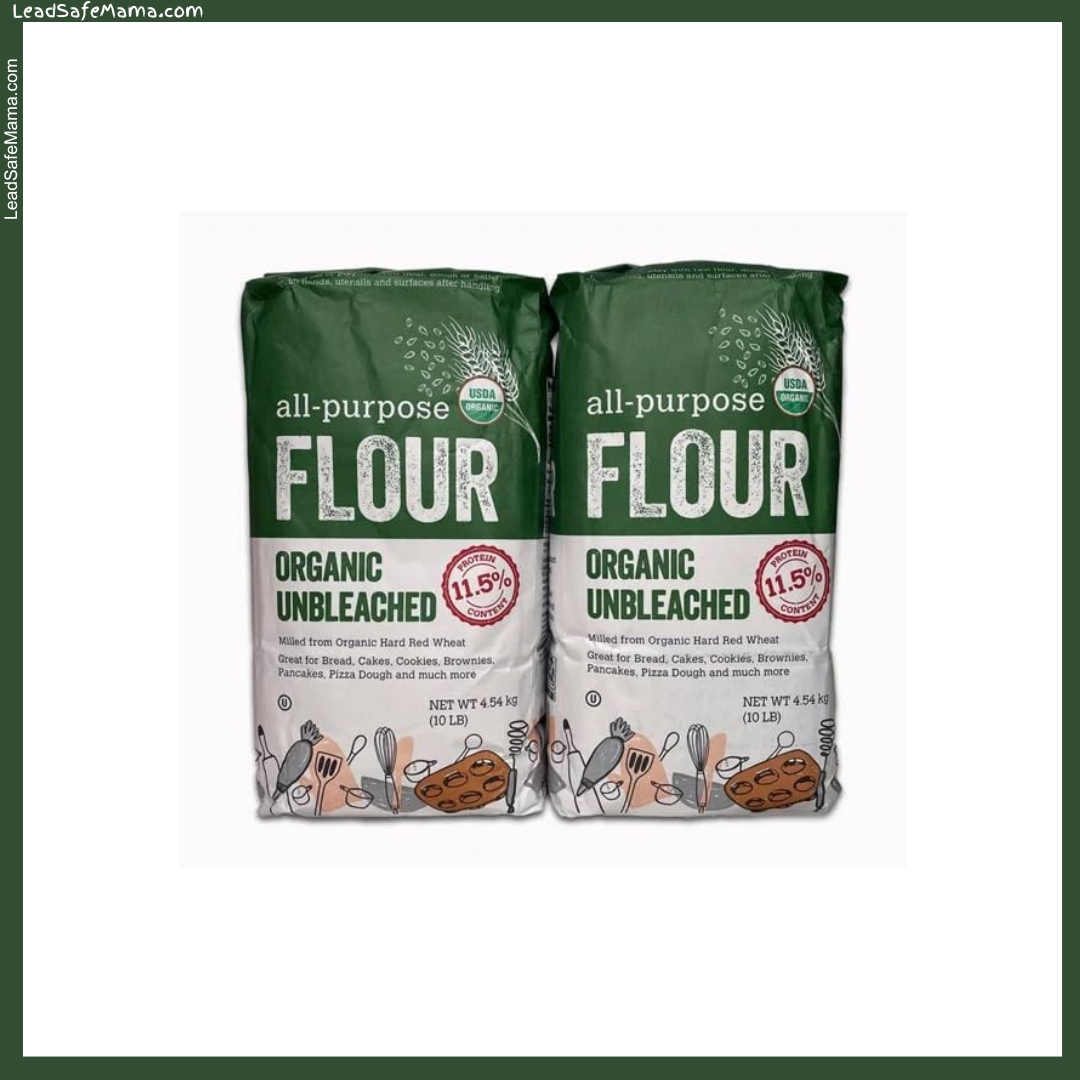
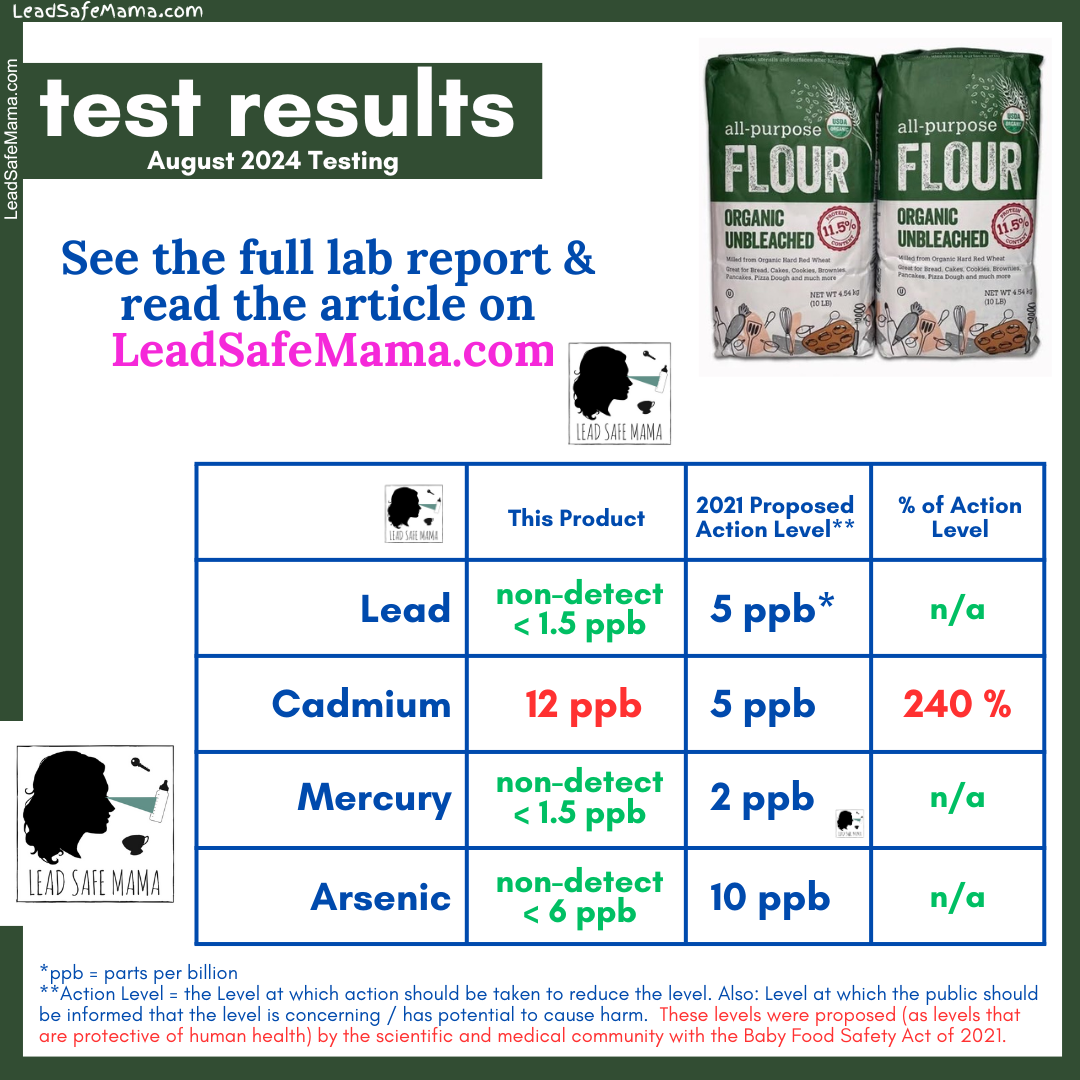
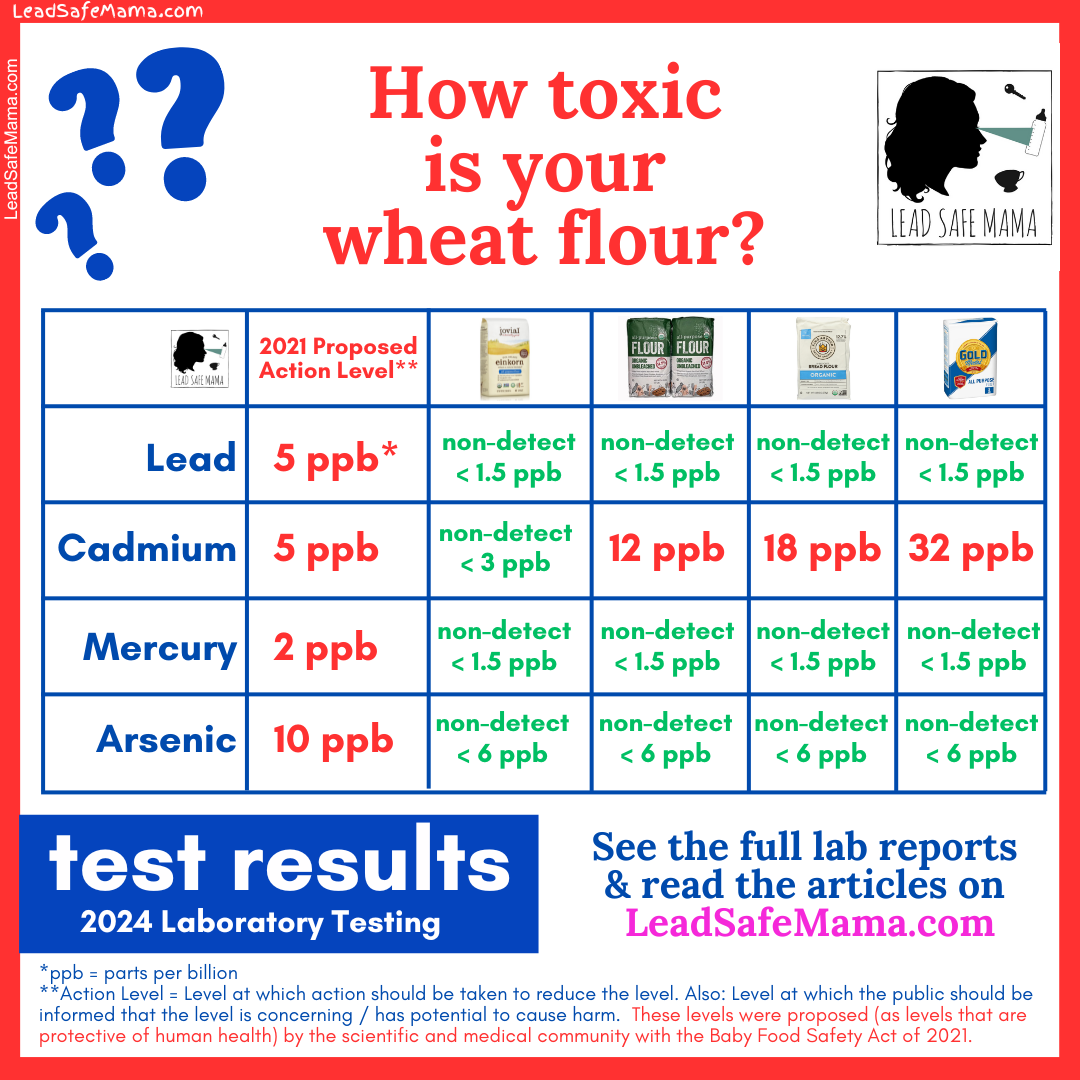
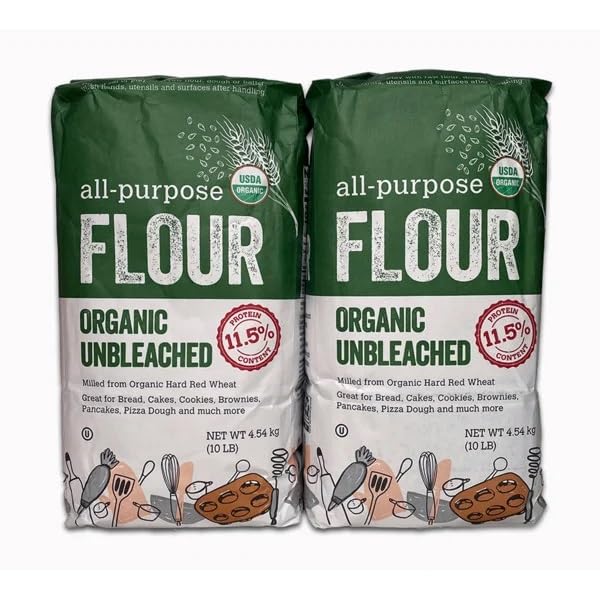
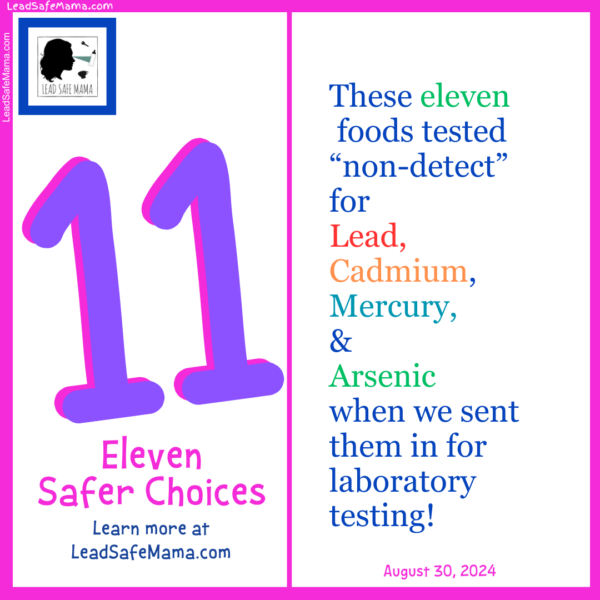
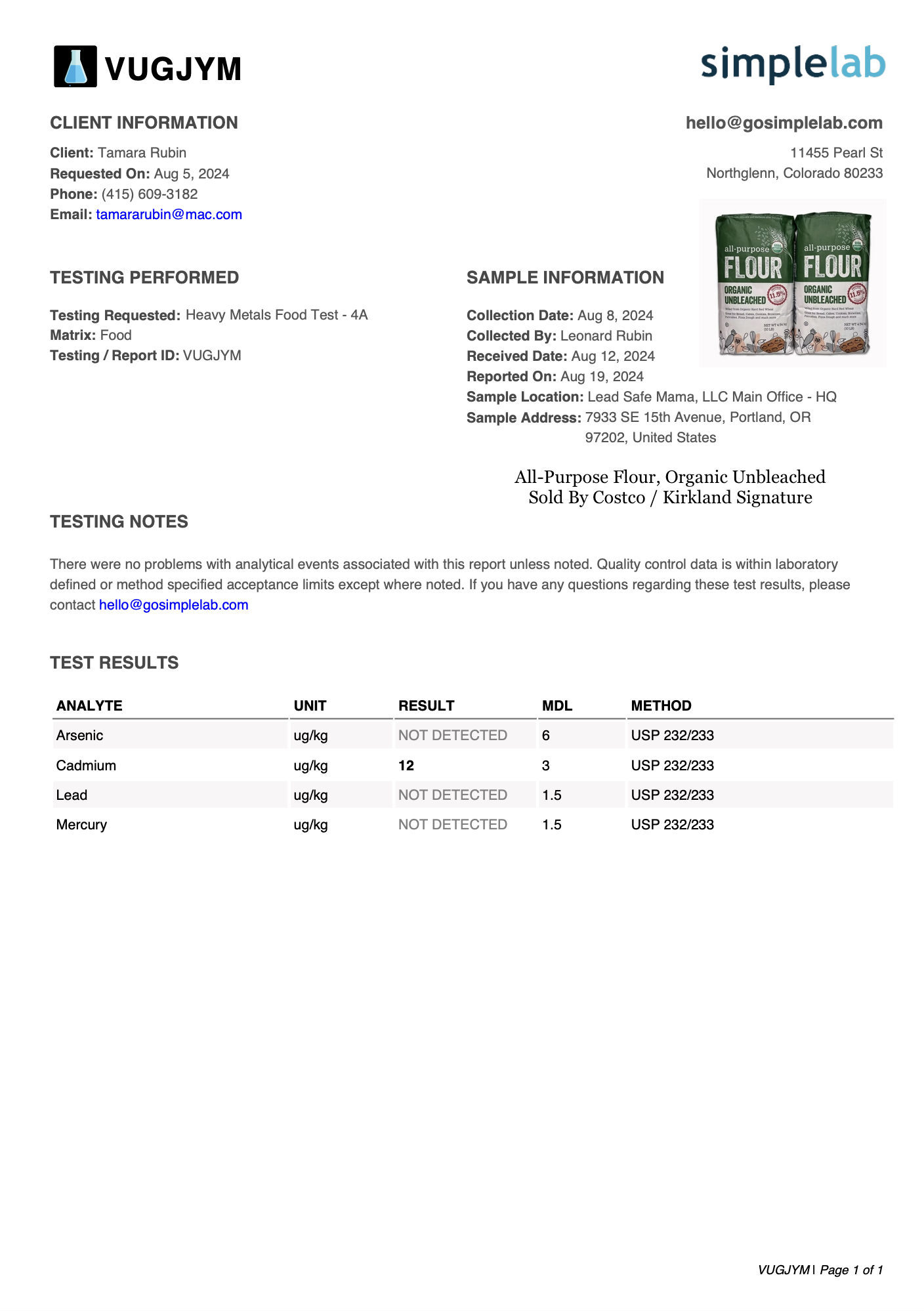

Darn, I didn’t expect this to test clean, but I hope soon another organic wheat flour will test clean. I’ve been waiting to see some results from a company in Oregon but I have a feeling they’re ignoring me on purpose!
Out of curiosity, which company? We used to live in Eugene and bought organic flour from Camas Mill. I’ve often wondered how that tests, but I can’t afford to ship it across the country.
Thank you Tamara! Do you think this could be avoided by purchasing whole wheat berries and grinding them ourselves?
I think it is possible – that is my theory at the moment, that this is coming from the processing (or that a large part may be coming from the processing!)
It would be interesting to find out if grinding your own wheat and grains reduces heavy metal contamination. That might also lead to testing the various grinders. I have used a Nutimill for years. I also use Costco organic flour, tested high for cadmium. I will need to start grinding more soft white wheat and sift it when I want fine flour to avoid the Costco flour.
We grind our own when we need it. I think it is generally a good practice (and also hopefully leads to less flour consumption). We mix different nuts, grains and seeds together for flour too – to add to the nutritional value.
T
What do you use for grinding?
Please test bobs red mill organic flour.
Hello! Thank you for commenting, this is Tamara’s son AJ answering questions.
My mom actually currently has a gofundme for Bob’s Redmill flour!
To donate directly and see the status of that testing campaign please visit this link:
https://www.gofundme.com/f/lead-safe-mama-lab-tests-bobs-red-mill-1-to-1-baking-flour?qid=f16f93150da197f8a1a571a14d6105d6
Thanks!
Thank you AJ!
– mom
The problem with cadmium being in flour has nothing to do with the milling. Cadmium is in the soil the grain is grown in. Roots of the wheat plants, as well as other roots of plants that are not wheat, absorb cadmium from the soil. It’s probable that the only way to lower cadmium in flour is to control how the farmer takes care of the soil the organic wheat is grown in.
While that is the food industry narrative – it falls apart given we have found a flour product that was non-detect for Cadmium:
https://tamararubin.com/2024/06/june-2024-laboratory-test-results-for-jovial-100-organic-einkorn-all-purpose-flour/
Tamara
I’m not so sure it falls apart. Einkorn and common wheat are different in many ways – one of them could be how they absorb minerals from the soil. Certain varieties of durum, for example, are known to absorb more heavy metals than others, and wheat breeders have developed varieties that dramatically decrease the absorption rate of metals that exist in the soil. That bit aside, soil can be treated (naturally and organically, of course) to minimize cadmium levels or alter the pH which can inhibit the plant’s absorbition of the metal. Organic fertilizers that a lot of farmers use (American and otherwise) can create an acidic environment, which increases the likelihood of wheat’s root structure to absorb cadmium. This is a long winded way of saying that it may be fruitless to focus on how the flour is milled and more productive for your search for clean flour sources to look at where and how the wheat is grown. The people over at Jovial are paying attention to that and/or are having their Einkorn grown in regions that have naturally low levels of cadmium in the soil.
This makes me so sad…like others have said, I didn’t expect it to be squeaky clean, but it’s still disappointing. How do you get rid of cadmium in your body? For lead, it sounds like garlic consumption (and some other foods you mentioned in that post). But what about cadmium?
Glyphosate binds with soil phosphorous and causes it to wash away, leaving the soil deficient in phosphorous. Farmers respond by buying “rock phosphate” and spreading it on their soil. It is contaminated with cadmium. Some sources have low contamination but others have high contamination:
https://www.sciencedirect.com/science/article/pii/S2468584422000678
Excessive use of glyphosate exacerbates the unsustainable use of phosphorous fertilizer:
“Europe has an unsustainable consumption of P, with only 16% of the P present in fertilizer reaching human food, while the main fraction is lost through net accumulation in agricultural soils, soil erosion, or crop residues.”
I assume the lack of sustainability is worse in the US, too.
Roundup is not allowed in Oragnic production so that “theory” falls apart.
As a farmer myself, phosphate fertilizers are removed from the field by harvesting a crop. It is considered a MACRO nutrient along with Nitrogen and Potassium. Unlike Nitrogen, which can be sourced from the air by legumes or via manures, potassium and phosphate are hard to find in manures in the quantities needed to produce an economical crop.
Most commercial farmers are NOT applying rock phosphate. It is expensive and has a lower amount of crop available P per ton. Most farmers apply either DAP (Di-Ammonium Phosphate) or MAP (Mono-Ammonium Phosphate). The source of the phosphate may be from mined rock, but it is processed by reacting it with acid to extract the phosphate fetilizer. The product is then cooled and granulated.
Organic Argriculture is not allowed to use this “synthetic” fertilizer so the raw crushed rock is usually spread on the field. It is possible to source phosphate fertilizer from manures or bone meal, but both of those sources have been caught with high amounts of arsenic in them. This was coming from the feed the poultry was consuming and from contamination in slaughter houses.
A previous poster pointed out that soil PH has a significant effect on the bioavailability of nutrients/metals to plants. MOST plants grow best when the soil PH is between 6 and 7 with neutral being ideal. When the soil becomes too acidic heavy metals become more available to plants. In some cases plants may absorb too much and it becomes toxic to the plant.
ALL commercial fertilizer, with the exception of manures, tend to push the PH lower over time. Famers counter this by applying “LIME” either calcitic or dolomitic, usually from crushed limestone, in order react with the acidic soil and raise the PH to more normal values. “Liming” a field is expensive. There are different grades of lime and the better quality options are much more expensive. It also takes time for this reaction to occur. Usually 6-12 months after working the limestone into the soil.
Most farmers only lime their fields once every 10 or so years. This can lead to some low PH values near the end of that 10 year cycle. Wheat is also not a very profitable crop per acre. There is a strong incentive to avoid extra inputs (lime) unless it is absolutely necessary.
I have found many Organic farmers, outside of large commercial operations, do not soil sample often or ever. They tend to by much smaller growers with less education on soil sciences, cation exchange ratios (the proper ratios of minerals to allow optimum plant growth) and how to manage them over time. Organic sources of nutrients (mostly manures and raw mined products) are not well standardized. Meaning they amount of nutrients per ton and contaminants are not well controlled.
My PERSONAL opinion is this is NOT a soil contaminant. It is more likely coming from the milling stones or is comes from paints/finishes on processing equipment. There are only a few millers in the United States that operate at a scale that can handle accounts like Costco. These mills are probably milling for ALL of the major brands, which is why they ALL have some level of cadmium. Cadmium WAS a common hardener/sticker in a lot of commercial glazes applied to milling equipment. There is a significant economic incentive to NOT identify a glaze or paint as the source. This would require either re-glazing, sand blasting and then re-coating the equipment with something like a baked on polyester OR replacing the equipment with stainless steel.
It could also be cadmium that may be present naturally in the milling stones. As four is milled a small amount of the stone is lost to friction and any heavy metals would then be present in the flour.
A good test would be to buy grain from farmer or local source, mill it in a home mill that uses steel burs. Then mill the same grain using stones. Almost no commercial millers are using steel burs. They would easily be damages by any small rocks or other hard objects. Milling stones are pretty much impervious to all by materials of the same hardness or harder (steel or pieces of iron).
There are other SMALL mills in the USA that could also be test. Great River Milling in Wisconsin is a small organic mill. They sell both processed flour and grain for mill at home. One could buy processed flour from them along with grain. Mill the grain at home using a mill that uses steel burs. Then send both samples for testing. If home milled grain is non-detect and the commercial milled product does detect heavy metals then you have poof that the contamination is happening during milling or packaging.
Costco’s all-purpose flour is most likely from Central Milling in PA. King Arthur mostly comes from Archer Daniels Midland (ADM). These are both huge millers that sell their own brands AND mill and pack under a private label. They buy grain on the open market and have no idea who the farmer/grower would have been. Only a small local mill would have traceability to the source. Central Milling and ADM are unlikely to sell you any grain. That said, any state that grows wheat will have a “grain elevator” that buys and sells wheat/corn/rye/etc. You can just go buy a bushel if you want raw commodity for testing. It would need to be cleaned before milling, but that would give you a raw “commercial” grain sample.
Thank you for taking the time to write this very detailed comment. I do want to say that we have tested unmilled grains and found similar Cadmium contamination results, so while I was originally exploring the theory that the contamination was primarily likely a contamination of processing – my thoughts on this have shifted with the additional testing we have done on whole grains and other products (ground crops and other crops that are consistently testing positive for high levels of Cadmium – like potatoes and peanuts) – products that are not milled or processed. There is also a UK study that I have referenced in some of my articles that specifically discusses the concern for Cadmium contamination from the use of phosphate rock fertilizer.
I do really appreciate your comment.
T
Are there any other organic millers who mill their own heritage grains like Red Fife or Turkey Red? I know Tamara is focused on metals, but I’m also concerned about glyphosate residue, which organic grains can have (eg, due to overspray from another grower). So far, the only company I’ve found that is proven to be clean for metals and glyphosate residue is Jovial’s ancient grain einkorn, which I love, but I want some higher-oven-spring flour. The Detox Project has a lot of brands listed, including Palouse, but Palouse is not offering any heritage grains.